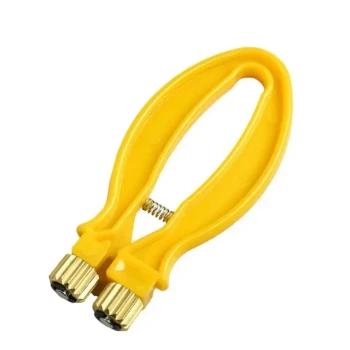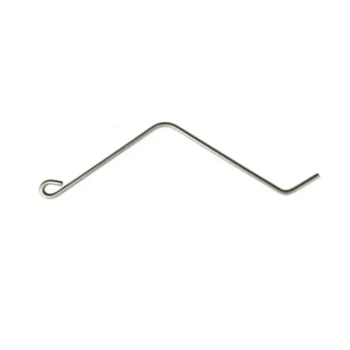At its core, wire mesh increases hive durability by addressing the two primary weaknesses of a traditional wooden hive: moisture retention and pest vulnerability. By integrating mesh, typically in a screened bottom board, you create a structure that is not only physically stronger but also promotes a healthier, drier internal environment that actively combats wood rot and common parasites.
A beehive is a wooden box exposed to the elements, making moisture its greatest enemy. Wire mesh is not just a material; it is a strategic system for ventilation and pest control that directly counters the main causes of hive degradation and failure.

The Core Functions of Wire Mesh in Hive Construction
Wire mesh is rarely used to construct an entire hive. Instead, it is strategically integrated at key points—most commonly the bottom board—to perform specific functions that dramatically enhance the longevity of the entire wooden structure.
Critical Moisture and Ventilation Control
The single most important role of wire mesh is ventilation. A solid wooden bottom board traps moisture, especially condensation that forms overnight or during winter.
This trapped moisture is the primary driver of wood rot and warping, which compromises the structural integrity of the hive body. A screened bottom board allows this moisture to drip out and facilitates constant, gentle airflow, keeping the wooden components dry and stable year-round.
Integrated Pest Management
A screened bottom board is a cornerstone of modern Integrated Pest Management (IPM), particularly against the Varroa destructor mite.
When mites fall off a bee, they drop through the mesh and are unable to climb back into the cluster. This passive reduction in mite load is a significant benefit. Furthermore, placing a sticky board under the mesh allows beekeepers to accurately monitor mite levels without disturbing the colony, enabling more precise treatment decisions.
Physical Reinforcement and Wear Resistance
While wood is susceptible to damage, steel mesh provides a tough barrier. It resists gnawing from pests like mice that may try to enter the hive from below.
It also stands up to the general wear and tear from beekeeping tools and frequent inspections far better than a simple wooden entrance or bottom board would.
Choosing the Right Mesh Material
The longevity of the mesh itself depends on its material and coating. Each type offers a different balance of cost and corrosion resistance.
Stainless Steel: The Premium Standard
Stainless steel mesh offers the highest level of corrosion resistance and will not rust, even in damp conditions. It is the most durable and long-lasting option, but also the most expensive. This is the "buy it for life" choice for beekeepers prioritizing maximum longevity.
Galvanized Steel: The Practical Workhorse
Galvanized steel is coated in a layer of zinc to prevent rust. It offers excellent durability for its cost and is the most common material used for screened bottom boards. The zinc coating can eventually wear away, but it provides many years of reliable service.
Epoxy-Coated Steel: A Budget-Friendly Alternative
This type of mesh uses a black epoxy coating as a barrier against moisture. While effective, this coating can be scratched by hive tools, creating a weak point where rust can begin. It is a viable, budget-conscious option, but it may require replacement sooner than galvanized or stainless steel.
Understanding the Trade-offs
While highly beneficial, a screened bottom board is not without its operational considerations. Understanding these trade-offs is key to using them effectively.
The Challenge of Wintering
The excellent ventilation of a screened bottom board becomes a liability in cold climates. Excessive airflow can make it difficult for the bee cluster to maintain its critical core temperature during winter.
For this reason, most beekeepers in cold regions use a closure board (often made of plastic or wood) to seal the screen during the coldest months, removing it again in the spring.
The Myth of Disease Resistance
The reference to disease resistance can be misleading. The steel mesh itself is non-porous and easy to clean, unlike wood which can harbor pathogens like foulbrood spores.
However, a mesh screen does not prevent the introduction or spread of bee diseases within the colony. Its benefit is purely one of material hygiene, not active disease prevention.
Making the Right Choice for Your Apiary
Integrating wire mesh is a strategic decision that pays dividends in hive health and equipment longevity.
- If your primary focus is maximizing hive lifespan: A screened bottom board is one of the single best investments you can make to prevent the wood rot that destroys hive bodies.
- If your primary focus is effective Varroa mite control: A screened bottom board is an essential tool for passively reducing mite loads and accurately monitoring infestations.
- If you operate in a very cold climate: Use a screened bottom board for its summer benefits, but be prepared to close it off with an insert to ensure your bees can overwinter successfully.
Ultimately, incorporating wire mesh into your hives is a proactive investment in the long-term resilience and sustainability of your apiary.
Summary Table:
| Function | Key Benefit | Impact on Hive Durability |
|---|---|---|
| Moisture Control | Ventilation prevents condensation | Eliminates primary cause of wood rot & warping |
| Pest Management | Passive Varroa mite reduction via IPM | Reduces pest pressure that weakens colonies |
| Physical Reinforcement | Resists gnawing from mice & tool wear | Protects hive structure from physical damage |
Ready to build more durable, resilient hives?
As a trusted supplier for commercial apiaries and distributors, HONESTBEE provides the high-quality wire mesh and screened bottom boards essential for long-term hive health. Our durable equipment directly combats moisture and pests—the main causes of hive failure—protecting your investment.
Let us help you equip your operation with the right materials for maximum longevity. Contact HONESTBEE today to discuss your wholesale needs.
Visual Guide

Related Products
- Professional Drop-Style Hive Handles for Beekeeping
- Mesh Ventilated 3 Layer Goatskin Beekeepers Gloves for Beekeeping
- Professional Galvanized Hive Strap with Secure Locking Buckle for Beekeeping
- Long Langstroth Style Horizontal Top Bar Hive for Wholesale
- Professional Pneumatic Wire Embedder for Beehive Frames
People Also Ask
- What are the characteristics of the bristles on a bee brush? Designed for Gentle Persuasion, Not Force
- What types of gloves are available for beekeeping? Choose the Right Protection for Your Hive
- Why are hive tools painted in bright colors? Prevent Losing Your Essential Beekeeping Gear
- What parts of bee equipment should be painted? A Guide to Protecting Your Hive and Your Bees
- How much time does it take to do beekeeping? A Realistic Breakdown for Beginners & Pros



















